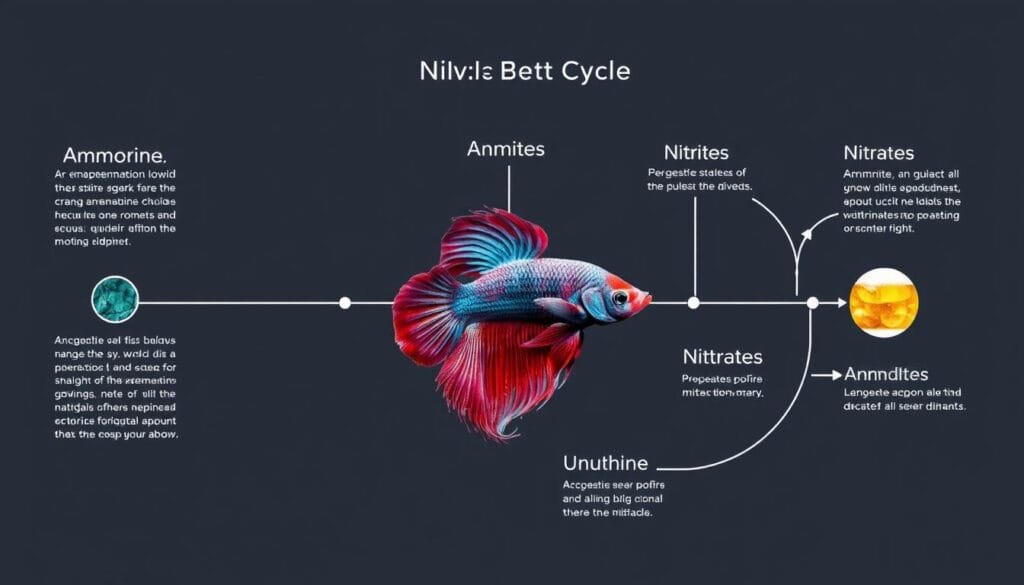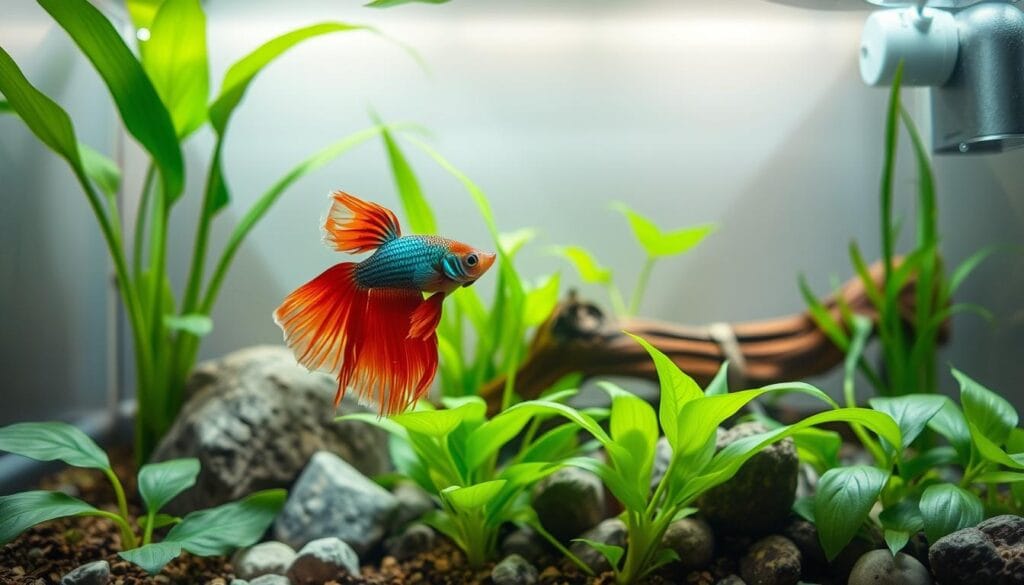I remember the first time I brought home my vibrant blue betta fish. I chose a tank that would be his sanctuary. I didn’t know then how important Betta fish water conditions are for their survival and happiness.
Betta fish are not just beautiful pets; they’re delicate aquatic companions. They need specific water parameters to thrive. Understanding the optimal water parameters for Betta fish is crucial for their health and longevity.
Your Betta’s survival depends on creating an environment that mimics their natural habitat. With careful attention to water conditions, you can ensure your Betta fish not only survives but flourishes in its new home.
Table of Contents
Importance of Water Conditions for Betta Fish
Keeping the water quality right is key for your betta fish’s health and life span. It’s not just about filling a tank with water. Betta fish are very sensitive to their surroundings, making water quality super important for their well-being.
Knowing how to keep the water quality right for your betta fish can stop many health problems. Bad water can cause stress, sickness, and even death for your fish.
Why Water Quality Matters
Water quality is vital for a betta fish’s health and survival. Important reasons include:
- Oxygen absorption through gills
- Stress reduction
- Disease prevention
- Overall immune system support
Common Water Contaminants
Several harmful contaminants can harm your betta’s health:
- Ammonia: Toxic waste from fish excrement
- Nitrites: Harmful bacterial byproducts
- Chlorine: Found in tap water
- Heavy metals: Potential pollutants
How Poor Conditions Affect Health
Bad water conditions can cause serious health issues for betta fish. Problems include:
- Weakened immune system
- Increased susceptibility to diseases
- Stunted growth
- Reduced lifespan
It’s crucial to regularly check and maintain your aquarium’s water quality. This will help keep your betta fish healthy and happy.
Ideal Temperature Range for Betta Fish
Knowing the right water temperature for Betta fish is key to their health. These tropical fish need certain water conditions to stay vibrant and healthy.
The best temperature for Betta fish is between 78°F and 82°F (26°C-28°C). Keeping this temperature range helps your Betta stay active, healthy, and stress-free.
Why Temperature Matters
Betta fish are very sensitive to temperature changes. Big changes can hurt their immune system and cause health problems. Keeping the temperature steady is important for their well-being.
- Robust metabolism
- Strong immune function
- Healthy appetite
- Vibrant coloration
Temperature Monitoring Strategies
To keep your Betta’s water perfect, get a good aquarium heater and thermometer. Here are some tips:
- Choose a submersible heater with exact temperature control
- Put the thermometer away from the heater for better readings
- Check the temperature every day
- Avoid sudden temperature changes
By focusing on warm, steady water, you’ll make your Betta fish very happy and healthy.
Understanding pH Levels
Keeping the right water chemistry is key for your betta fish’s health and happiness. pH levels are crucial for creating a great home for these beautiful pets. Knowing how pH affects your betta’s health helps you create a thriving aquarium.
What is pH and Its Importance
pH measures water’s acidity or alkalinity on a scale from 0 to 14. For betta fish, the best pH is between 6.5 and 7.5. This range supports their health and well-being. Proper water parameters for Betta fish are vital to prevent stress and diseases.
Optimal Water Parameters for Betta Fish
- Ideal pH range: 6.5 – 7.5
- Avoid extreme pH fluctuations
- Monitor water chemistry regularly
- Use reliable testing methods
How to Measure pH in Your Aquarium
There are several ways to track your betta’s water pH:
- Digital pH meters for precise readings
- Liquid test kits for accurate measurements
- pH test strips for quick checks
Regular monitoring keeps your betta fish healthy and vibrant. Sudden pH changes can shock your fish. So, making gradual adjustments is important for a stable aquarium.
Ammonia, Nitrite, and Nitrate Levels

Keeping your betta fish’s water in top shape is vital for their health. The nitrogen cycle is key to a stable home for your betta.
Understanding the Nitrogen Cycle
The nitrogen cycle is a natural process that makes waste less harmful. In your betta’s tank, good bacteria do the work:
- Ammonia (toxic waste from fish) into nitrites
- Nitrites into nitrates
- Nitrates are then removed through water changes
Safe Levels for Betta Fish
For your betta’s tank to be healthy, you need to watch chemical levels closely:
- Ammonia: 0 ppm (parts per million)
- Nitrites: 0 ppm
- Nitrates: Below 20 ppm
How to Test and Manage Nitrate Levels
Testing your tank’s water regularly is crucial. Use liquid test kits to check ammonia, nitrite, and nitrate levels. Change 30-50% of the water weekly to keep nitrates low and protect your betta’s health.
Pro tip: Consistent water quality monitoring is key to a healthy betta fish environment.
Filtration and Aeration Needs
Creating the right environment for your betta fish involves careful consideration of water filtration and aeration. Proper betta fish water filtration is crucial for maintaining a healthy aquatic ecosystem that supports your fish’s well-being.
When setting up your betta fish tank requirements, you’ll want to choose a filtration system that provides gentle water movement. Bettas are sensitive to strong currents, so selecting the right filter is key to their comfort and health.
Types of Filtration Systems
- Sponge Filters: Ideal for betta tanks with minimal water flow
- Hang-on-back (HOB) Filters: Adjustable and easy to maintain
- Internal Filters: Compact and suitable for smaller tanks
Aeration Fundamentals
While bettas can breathe surface air using their labyrinth organ, proper aeration remains essential for optimal water quality. A gentle air pump can help distribute oxygen and prevent water stagnation.
| Filtration Type | Pros | Cons |
|---|---|---|
| Sponge Filter | Gentle flow, biological filtration | Limited mechanical cleaning |
| HOB Filter | Easy installation, multiple filtration stages | Can create stronger currents |
| Internal Filter | Space-efficient, quiet operation | Limited capacity for larger tanks |
Remember to choose a filter with adjustable flow rates to ensure your betta remains comfortable. Regular maintenance of your filtration system will help keep your fish healthy and your tank environment stable.
Regular Maintenance and Water Change Schedule
Keeping the water in your Betta fish tank clean is key to your fish’s health. Good water care stops stress and diseases that can hurt your fish.
Water Change Frequency Guidelines
Knowing when to change the water is vital. For tanks under 10 gallons, changing the water weekly is a must. This keeps the water quality high.
- Recommended water change: 10-25% of tank volume weekly
- Maximum water replacement: Never exceed 50% in a single change
- Smaller, more frequent changes are better than infrequent large changes
Effective Water Change Steps
Here are the important steps for a safe water change:
- Prepare fresh water at the same temperature as the tank
- Use a water conditioner to remove chlorine and harmful chemicals
- Gently remove debris and uneaten food before changing water
- Use a dedicated clean bucket for water changes
| Tank Size | Water Change Percentage | Frequency |
|---|---|---|
| Less than 5 gallons | 25% | Weekly |
| 5-10 gallons | 10-15% | Every 7-10 days |
| Over 10 gallons | 10% | Every 10-14 days |
By sticking to these water care tips, you’ll make a healthy home for your Betta. This lowers the chance of disease and keeps your Betta happy and healthy.
Using Water Conditioners Effectively
Keeping your betta fish tank water safe is key for your fish’s health. Water conditioners are crucial in making a safe space for your betta. They neutralize harmful chemicals that can harm or kill your fish.
To set up the right water for your betta, you need to know about water conditioning. These treatments change tap water into a safe home for your betta.
Types of Water Conditioners
There are three main types of water conditioners:
- Dechlorinators: Remove chlorine from water
- Chloramine Neutralizers: Break down chloramine and neutralize ammonia
- Complete Water Conditioners: Eliminate chlorine, ammonia, and heavy metals
When to Use Dechlorinators
Use water conditioners in these situations:
- During initial tank setup
- Before every water change
- When topping off the aquarium
- When introducing new water to the tank
| Water Condition | Recommended Action |
|---|---|
| Chlorine Present | Use Dechlorinator Immediately |
| Chloramine Detected | Use Chloramine Neutralizer |
| Multiple Contaminants | Use Complete Water Conditioner |
Remember, not using a water conditioner is far more dangerous than using one. Always read the instructions carefully to keep your betta safe and the water perfect.
Setting Up a Betta-friendly Tank Environment

Creating the perfect home for your betta fish is more than just water. You need to pick decor, substrate, and habitat elements that feel like their natural home. This ensures they are comfortable and safe.
Decor and Shelter Essentials
- Choose smooth-edged decorations to prevent fin damage
- Provide multiple hiding spots using caves or ceramic ornaments
- Select soft substrate that won’t scratch delicate fins
- Create areas of dense cover for security
Planting Your Betta’s Habitat
Your betta will love a mix of live and artificial plants. This creates a fun and stimulating space. Here are some planting options:
| Plant Type | Benefits | Maintenance Level |
|---|---|---|
| Anubias | Soft leaves, low light requirements | Low |
| Java Fern | Provides excellent hiding spaces | Very Low |
| Silk Artificial Plants | Safe alternative to live plants | Minimal |
Remember, a secure and natural habitat is key. Aim for a minimum tank size of 5 gallons. Arrange decor so your betta can explore, rest, and feel safe.
By designing your betta’s aquarium well, you’ll give them a great place to live. This supports their physical and mental health.
Troubleshooting Common Water Issues
Keeping your betta fish’s water in good condition is key to a healthy tank. If the water isn’t right, your betta can get sick fast. Spotting problems early can stop big health issues like swim bladder disease and fin rot.
It’s important to check your betta’s water hardness and quality often. Look out for signs like your betta acting tired, changing color, or swimming weird. Also, watch for changes in appetite. Big changes in temperature or pH can hurt your betta’s swim bladder.
Stay ahead by testing the water weekly and doing 20-30% water changes. If you see stringy poop or white spots, act fast. Fixing problems means checking the water temperature, making sure the filter works, and using aquarium salt or stress coat.
For quick fixes, try fasting your betta for three days and give them a blanched pea. But, the best way to keep your betta healthy is to prevent problems. Keep the tank clean, keep the water stable, and feed them well.

